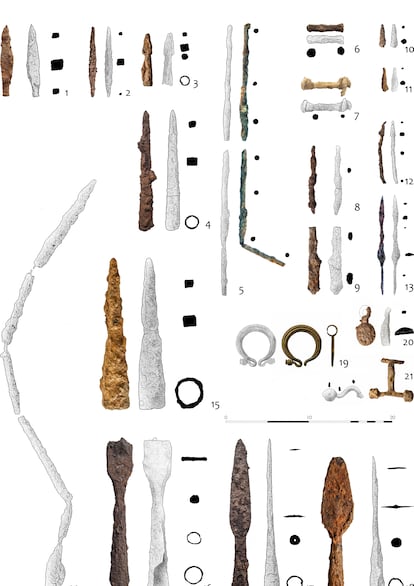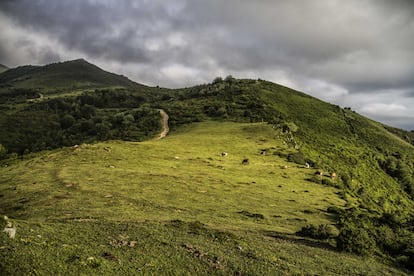Between the years 29 BC. C. and 19 a. C., Emperor Augustus undertook the conquest of the last peninsular territories that resisted Rome: those occupied by the Asturian-Cantabrian tribes. To complete control of northern Hispania, three mountain camps were built in transmontana Asturia located in the La Carisa mountain range, between the provinces of León and Asturias. It was about three summer camp (field barracks in summer) located in the mountains of Ḷḷagüezos, Coaña and Currieḷḷos. Associated with them was a strategic route that linked the Duero Valley with the Cantabrian Sea and crossed mountains up to 2,000 meters high. Now the study Militaria in the Cantabrian wars. La Carisa axis of operations, by archaeologist Esperanza Martín, reveals “the discovery of 200 pieces belonging to the troops (quartered in Ḷḷagüezos and Coaña), which include weapons, tools, clothing components and elements of military equipment.” Among these objects, stands out a punch (reinforced dagger that could pierce a chain), axes, anvils, swords, arrows and spearheads.
Ḷḷagüezos was the southernmost settlement in the mountain range and stood 1,675 meters above sea level. It occupied eight hectares, divided into four enclosures. Its enormous size allowed it to house a legion of between 4,000 and 5,000 men. Its upper part, at the top of the hill, was flat, while the eastern and northern sides were terraced to accommodate more troops. These last areas formed the first line of defense of the upper camp, where a stone-built barracks was located. The entire military complex was surrounded by a mound and ditch or embankment with a moat formed by a stone parapet, and a palisade of thick logs.
A 40-minute walk away was the Curriellos cantonment (7.35 kilometers) and nine minutes away was the Coaña cantonment. The latter was at a lower height than the other two and had no visual connection with them. It only occupied 0.6 hectares, but curiously it is where the most “material remains” have been located.
The archaeologists have eliminated from their count the military elements of “contemporary chronology”, since they are, by far, the most numerous on the summits, because the hill was occupied during the Civil War (1936-1939) by Francoist troops in order to to control the passage of the maquis through the mountain. The number of shells, accordion parts, cables and rifle elements recovered exceeds 300. “It is not trivial,” says the expert, “to highlight the choice of the same site during the Roman conquest, as it was the ideal place from which to They could protect all the mountain passes. The geostrategic position of the Ḷḷagüezos hill made it the best place to establish itself from a military point of view.”
The Roman materials found in Llagüezos include tent pegs, guy wires and pegs in their original position, which has made it possible to calculate the diameter of the tents between 2.5 and 2.7 meters, measurements very similar to those documented in Vindolanda, one of the forts that guarded Hadrian’s Wall (Great Britain). The pegs, furthermore, do not all have the same weight and length, “which allows us to think about different manufacturing hands.”
A hoe was also recovered in Llagüezos, as well as chisels, hooks and chains. A very small portable anvil (11 cm) was also found, which could have been used for specific repairs to weapons. As for attack weapons, they have been recovered balls (javelins), spearheads, artillery projectiles (catapult dick), darts and small arrows of the Syrian type. “A large group that demonstrates a long period of settlement,” according to Martín. Only one defensive weapon has been unearthed, an umbo, a metal piece that was placed in the center of the shields. It was located in one of the areas where the legionnaires carried out control rounds, in the western part of the camp, the only point where it could be attacked.
The knives located respond to different types: curved, straight, with quadrangular handles, with a round tang, and even a possible pocketknife. Of them, stands out a punch on one of the slopes of Llagüezos. It is complete (blade and sheath), but is poorly preserved and has a broken handle. It was found just two centimeters from the surface. Esperanza Martín’s study indicates that its “iron handle has a curved section and is two millimeters thick, maintaining a thin layer of red organic material on the handle, which may correspond to red leather.” All of its rivets appear to be made of silver. Currently, the restorer Miryam Hernández is analyzing it at the León Museum. The sheath of the dagger is padded with wood inside. Its external decoration cannot be determined, given its poor condition. It measures 25 centimeters and its width is 5.5.

The Llagüezos camp was raised during the operations carried out by the military column in charge of entering the heart of transmontana Asturia, following the axis of the La Carisa road. This was a strategic infrastructure that started from León and had the Cantabrian coast as its destination, undoubtedly the Gijón area.
The archaeologist considers that these camps were not only used during the Cantabrian wars, but also continued to be used in the following years “as a consequence of the revolts.” “Depending on the moment, Llagüezos could have served as headquarters,” he says.
Precisely the location of three keys reinforces this hypothesis. One of them, the largest, measures 55 centimeters and has two teeth on the drill bit and a hinge in the center of its articulated handle. “The discovery of the large articulated key,” the report reads, “may be of special interest because it may be linked to an entrance door to the large buildings of the principia (headquarters)”, which means “a certain stability of the facilities, even if they were summer. “It is likely that the tents were replaced by a stone barracks.”
The study ends up calculating the number of troops housed in the barracks, which ranged between five cohorts in Coaña and Curriellos (about 2,000 soldiers) and a legion (between 4,000 and 5,000), in Llagüezos.

